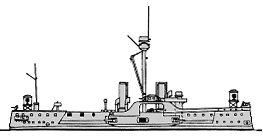
NAVYPEDIA
 Support the project with paypal
Support the project with paypal
Photo

Oldenburg 1887
Ships
| Name | No | Yard No | Builder | Laid down | Launched | Comp | Fate |
|---|---|---|---|---|---|---|---|
| Oldenburg | 132 | Vulcan, Stettin | 1883 | 20.12.1884 | 8.4.1886 | guardship 1900, later harbour ship, sold as target 1.1912 |
Technical data
| Displacement normal, t | 5652 |
|---|---|
| Displacement full, t | 5743 |
| Length, m | 79.8 oa 78.4 wl |
| Breadth, m | 18.0 |
| Draught, m | 6.30 |
| No of shafts | 2 |
| Machinery | 2 HC, 8 cylindrical boilers |
| Power, h. p. | 3942 |
| Max speed, kts | 13.8 |
| Fuel, t | coal 450 |
| Endurance, nm(kts) | 1370(10) |
| Armour, mm | compound; belt: 300 - 200, battery: 200 - 150, bulkheads: 152, deck: 30, CT: 50 |
| Armament | 8 x 1 - 238/28 RKL/30 C/84, 4 x 1 - 149/20 RKL/22 C/72, 2 x 1 - 87/22 RKL/24 C/82, 4 - 350 TT (1 bow, 2 beam, 1 stern) |
| Complement | 389 |
Standard scale images

Oldenburg 1898
Graphics
Project history
The Oldenburg, designed between 1879 and 1881, was considered to be of little fighting value by the time she was completed. She had originally been intended as a ship of the Sachsen class, but funds for this proved insufficient. Her main armament was mounted in a central battery, six guns on the main deck, two firing on the broadside, and the others set in embrasures to give an approach to end-on fire fore and aft. The remaining two 240mm guns were placed above the battery an the upper deck, firing on the broadside.
Ship protection
Compound steel-iron armour was used. Main belt was consisted of upper strip (300mm in the citadel and 200mm outside citadel) and lower strip (250mm in the citadel and 180mm outside), both were backed by 250(citadel)-300mm (ship ends) wood. Casemate was protected by 200 (amidships) - 150mm (to the ends of casemate) armour backed by wood (200mm amidships and 250mm to the ends). Armour deck was 30mm thick. Main CT had 50mm sides and 25mm roof, aft CT had 15mm sides and 12mm roof.
Modernizations
1890s: + 6 x 1 - 87/24 RKL/22 C/82
late 1890s: - 6 x 1 - 87/22; + 6 x 1 - 50/37 SKL/40
Naval service
Nicknamed the 'Flatiron', she became a harbour guard ship in 1900. After 1912 she continued to be used as a target ship. She was broken up in 1919.
 HOME
HOME FIGHTING SHIPS OF THE WORLD
FIGHTING SHIPS OF THE WORLD GERMANY
GERMANY CAPITAL SHIPS
CAPITAL SHIPS OLDENBURG central battery ironclad (1886)
OLDENBURG central battery ironclad (1886)
